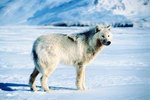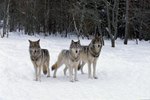Historically, black wolves have been hunted and driven nearly to the point of extinction -- but they aren’t the only wolves at risk. Black wolves are actually a type of gray wolf -- the name of the species is a misnomer, as gray wolves are sometimes born black because of a genetic mutation. The population is growing now, thanks to human intervention, but hunting and other activities still affect these creatures.
Black and Gray
Though they are called “gray wolves,” these animals come in colors that include white and black. Black wolves originated because of interspecies breeding between gray wolves and domesticated dogs -- this led to a genetic mutation that has made black-colored gray wolves grow in population. These black wolves are more common in forested areas, as their coloring gives them more of an advantage in that environment -- they can't camouflage themselves in the snowy areas, where white-colored gray wolves live. Because they survive more easily in wooded habitats, the gene that causes black fur is more prevalent there.
Historical Extermination
Wolves are generally feared -- this, along with their tendency to kill domesticated animals and livestock, made them a target for hunters. In some cases, eradicating wolves was sanctioned by local governments, which rewarded hunters with bounties. By the mid-20th century, the worldwide wolf population was down to about 200,000, when it had once been in the millions.
Deforestation and Prey
The gray wolf population has been affected by other types of human activity, as well. For example, humans and wolves have historically competed for certain types of food, like caribou, bison, moose and deer. As humans have hunted this prey with increasing effectiveness, less has been left for wolves to subsist on. Human deforestation efforts have also contributed to the endangerment of wolves -- this is especially true of black-colored gray wolves, which live primarily in wooded areas.
Conservation
As of 1969, the gray wolf -- in all its colors -- was listed as endangered by the U.S. Fish & Wildlife Service. Conservation efforts since that time have included criminalizing wolf hunting, reintroducing wolves to areas where they had died off -- particularly in the western United States -- and increasing wolf populations in protected areas, like Yellowstone National Park. These conservation efforts have been successful, and gray wolves -- including the black ones -- face no immediate threat of extinction.
References
Writer Bio
Tom Ryan is a freelance writer, editor and English tutor. He graduated from the University of Pittsburgh with a degree in English writing, and has also worked as an arts and entertainment reporter with "The Pitt News" and a public relations and advertising copywriter with the Carnegie Library of Pittsburgh.





